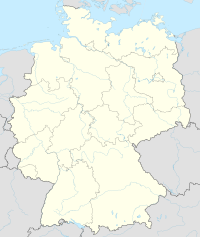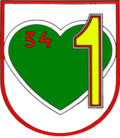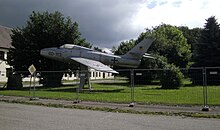Fighter-bomber squadron 34
|
Fighter Bomber Squadron 34 "Allgäu" |
|
|---|---|
 Internal association badge (coat of arms) |
|
| active | October 1, 1958 to June 30, 2003 |
| Country |
|
| Armed forces |
|
| Armed forces |
|
| Strength | approx. 2400 soldiers |
| Insinuation |
|
| last position |
|
| Awards |
Bavaria (1988) |
| commander | |
| last commodore | Colonel Norbert Geissendörfer |
| Aircraft | |
|
Fighter aircraft / helicopter |
Tornado "IDS" |
Location Memmingerberg Air Base Coordinates: N47 ° 59 ′ 20 ″ E10 ° 14 ′ 22 ″ |
The Jagdbombergeschwader 34 "Allgäu" was from October 1, 1958 to June 30, 2003 an air force squadron of the German armed forces at the Memmingerberg location in Bavaria .
history
Lineup
The Jagdbombergeschwader 34 was set up on November 29, 1958 in Nörvenich and in the same year relocated to Faßberg , where it received the first aircraft of the type Republic F-84 F "Thunderstreak". In April 1959 the association got its final location , the Memmingerberg Air Base , which was built before the Second World War and, after the Bundeswehr was set up, was used by the “S” pilot school for transport pilot and helicopter training and for blind flight training. The squadron's official commissioning under its first Commodore Carl-Heinz Greve took place on May 5, 1959 in the presence of Defense Minister Franz Josef Strauss and the Inspector of the Air Force , Lieutenant General Josef Kammhuber . On October 1 of the same year, the association was signed to NATO .
Crash of two F-84 fighter planes in Czechoslovakia
On October 22, 1959, two F-84F fighter aircraft (with the code DD + 106 and DD + 107) belonging to the squadron were missing during a training flight . The two pilots, Sergeant Kraus and Sergeant Hoffmann, had previously reported problems with the oxygen supply. Later they went into a descent. After the radio connection in the area of the Fürstenfeldbruck air traffic control area was broken , an extensive search was then initiated with the participation of the German armed forces , police, fire brigades and US armed forces and initially searched the Memmingen area and, after evaluating the radar results, the Upper Franconia - Upper Palatinate area by October 30, 1959 , including a 60 km long border section to the GDR and Czechoslovakia . Politically, this incident was very explosive during the Cold War . In the press there were suspicions that it was a spy flight over Czechoslovak territory. The search was stopped on November 2nd. The Federal Republic of Germany asked the USA to help with the investigation, since in 1959 there were no diplomatic relations with Czechoslovakia due to the Hallstein Doctrine . On November 16, 1959, the Czechoslovak government confirmed the crash. It was also reported that both pilots were able to save themselves with the ejector seat and were in custody in Czechoslovakia. Thereupon the Federal Republic expressed its regret over the unintentional border violation with Czechoslovakia and asked the USA for assistance in the return of the pilots.
The crash sites of both aircraft, less than a kilometer apart, were near the Dyleň, not far from the border with Bavaria.
After a lawsuit on charges of espionage , which ended with a conviction for damages (which the Federal Republic was to take over), the two pilots were released on December 2, 1959 at the Waidhaus border crossing point .
The pilots were received by Minister Franz Josef Strauss at the Ministry of Defense in Bonn on December 3 and presented to the press.
The starfighter era
In 1964, Fighter Bomber Wing 34 was subordinated to the 1st Air Force Division. In the same year, the conversion to the F-104G "Starfighter" began . The three aircraft types Piaggio P.149 D, Dornier Do 28 D-2 Skyservant ("Allgäu Express") and Lockheed T-33 T-Bird were used in the squadron as liaison aircraft for the transport of personnel and material . An alarm riot was stationed at the eyrie, which - unlike the alarm ranks of the fighter squadrons in the event of a conflict - had the task of using nuclear weapons to combat specified targets in the area of the Warsaw Pact.
After celebrations for the tenth anniversary of the commissioning took place on May 5, 1969, Fighter Bomber Wing 34 received the 1971 Aviation Safety Award for accident-free flying in 1972 . In 1980 the squadron and the Rottal-Inn district entered into a partnership in memory of Captain Axel Ruge, who died in a plane crash that same year.
Two years later, in March 1982, Fighter Bomber Wing 34 was awarded the Prinz Heinrich Prize for outstanding performance. It received this award again in 1983 and 1991.
On November 26, 1982, the squadron took over the tradition of the former Jagdgeschwader 54 "Grünherz ". As a sign of the takeover, the squadron captain of the 1st flying squadron was given the "Green Heart" coat of arms. At the beginning of the following year, the “Central Training Unit F-104 G” (ZAE) started flight operations. For the 25th anniversary of the squadron's commissioning and the 50th anniversary of the Memmingerberg air base, a flight day took place on May 5th, 1984 .
Conversion to the tornado
In 1987 the last formation of the Air Force began to convert to the new Panavia Tornado aircraft type . The fly-in of the first tornado and the fly-out of the "Starfighter" was celebrated on October 23, 1987. By this time, the squadron had completed 242,785 flight hours on the F-104.
On December 21, 1988, Thomas Goppel awarded the squadron the banner of the Free State of Bavaria, and on December 21, 1990 it received the "Certificate of Honor of the NATO Commander-in-Chief of the Allied Forces Central Europe (CINCENT)", which recognized the success in the tactical review best squadron documented in Central Europe in 1988. On May 8, 1992 it was given the nickname "Allgäu". In the same month, the "Military History Teaching Collection Air Base Memmingerberg" opened at the air base.
On August 25, 1995, two tornadoes of the association collided near Babenhausen . The crews of both machines were able to save themselves with the ejection seat and survived the accident.
After the US nuclear weapons were permanently transferred to the Büchel Air Base in accordance with the concept of nuclear participation , the 605th MUNSS ( MUN ition S upport S quadron) of the US Air Force was officially adopted on February 29, 1996 on the market square in Memmingen.
Dissolution of the squadron
The end of the squadron was decided in the course of taking Air Force Structure 5 at the end of 2000. On December 31, 2002, operational flight operations were officially ceased. The final decommissioning took place on June 30, 2003. The Memmingerberg Air Base, on which the fighter-bomber squadron was stationed, was disbanded the following year and is now used civilly as the regional Memmingen airport (also Allgäu Airport ).
In 2004 the training workshop of the now disbanded squadron was relocated to the Air Force 1 Technical School in Kaufbeuren .
Commodore

| No. | Rank | Surname | vocation |
|---|---|---|---|
| 1. | Colonel | Carl-Heinz Antonius Greve | from 1959 |
| 2. | Colonel | Günther Rall | from 1964 |
| 3. | Lieutenant colonel | Hans-Ulrich Flade | from 1966 |
| 4th | Lieutenant colonel | Georg Kunz | from 1969 |
| 5. | Lieutenant colonel | Jörg Kuebart | from 1970 |
| 6th | Colonel | Joachim Liedtke | from 1972 |
| 7th | Colonel | Bruno von Mengden | from 1975 |
| 8th. | Colonel | Hermann Hammerstein | from 1980 |
| 9. | Colonel | Jürgen Höche | from 1983 |
| 10. | Colonel | Jürgen Stehli | from 1985 |
| 11. | Colonel | Horst Lemke | since 1990 |
| 12. | Lieutenant colonel | Andris Freutel | from 1992 |
| 13. | Lieutenant colonel | Karlheinz Viereck | from 1994 |
| 14th | Lieutenant colonel | Heinrich Schneider | from 1996 |
| 15th | Lieutenant colonel | Uwe Ahrens | from 1999 |
| 16. | Colonel | Norbert Geissendörfer | from 2003 |
Symbolism of the association badge
Two stylized aircraft with lowered noses on a deep, dark blue background symbolize the medium of air in which the squadron moves. The star of NATO in the upper left part of the badge indicates the association's affiliation with this organization. In the lower half the snow-capped Alps are depicted, in whose foothills the Heimathorst was located. White and blue stand for the colors of the Free State of Bavaria as the federal state in which the association was stationed.
Web links
Individual evidence
- ↑ Jagdbombergeschwader 34. In: History of the Air Force - Associations. Bundeswehr, accessed on July 9, 2018 .
- ↑ Bernd Lemke , Dieter Krüger , Heinz Rebhan, Wolfgang Schmidt : The Air Force 1950 to 1970. Conception, structure, integration . Oldenbourg Wissenschaftsverlag, Munich 2006, ISBN 3-486-57973-8
- ↑ Letecká badatelna (Czech) (accessed October 10, 2016)
- ↑ bundesarchiv.de: Special events in the Bundeswehr ( Memento of the original from November 10, 2010 in the Internet Archive ) Info: The archive link was inserted automatically and has not yet been checked. Please check the original and archive link according to the instructions and then remove this notice.
- ↑ Crash over enemy territory
- ↑ A chronicle of the tornado crashes ( memento of the original from June 5, 2015 in the Internet Archive ) Info: The archive link was automatically inserted and not yet checked. Please check the original and archive link according to the instructions and then remove this notice. (PDF; 218 kB)





